High-Speed Visible Light Communications: Enabling Technologies and State of the Art
Abstract
:1. Introduction
2. Potentials of VLC System
- (1)
- Bandwidth resource
- (2)
- Safe
- (3)
- Security/privacy and interference
- (4)
- Low cost and energy efficient
- (1)
- Indoor high-speed network access: Li-Fi
- (2)
- Underwater communication
- (3)
- Intelligent transportation
3. Enabling Technologies for a High-Speed VLC System
3.1. LED Technology
- (1)
- Resonant Cavity LEDs (RC-LED)
- (2)
- Micro LEDs (μ-LED)
- (3)
- Laser diodes (LDs)
3.2. Advanced Modulation
- (1)
- OFDM
- (2)
- CAP
- (3)
- CSK
3.3. Equalization
- (1)
- Hardware equalization
- (2)
- Software Equalization
3.4. Blue Filter
4. State of Art
5. Limitations
6. Conclusions
Acknowledgments
Author Contributions
Conflicts of Interest
References
- Jackson, D.K.; Buffaloe, T.K.; Leeb, S.B. Fiat lux: A fluorescent lamp digital transceiver. IEEE Trans. Ind. Appl. 1998, 34, 625–630. [Google Scholar] [CrossRef]
- Wang, S.-W.; Chen, F.; Liang, L.; He, S.; Wang, Y.; Chen, X.; Lu, W. A high-performance blue filter for a white-led-based visible light communication system. IEEE Wirel. Commun. 2015, 22, 61–67. [Google Scholar] [CrossRef]
- Parikh, H.; Chokshi, J.; Gala, N. Wirelessly transmitting a grayscale image using visible light. Int. J. Comput. Appl. 2012, 58, 1–6. [Google Scholar] [CrossRef]
- Classen, J.; Chen, J.; Steinmetzer, D.; Hollick, M.; Knightly, E. The spy next door: Eavesdropping on high throughput visible light communications. In Proceedings of the International Workshop on Visible Light Communications Systems, Paris, France, 11 September 2015; pp. 9–14. [Google Scholar]
- Zhao, S.; Xu, J.; Trescases, O. A dimmable led driver for visible light communication (VLC) based on llc resonant dc-dc converter operating in burst mode. In Proceedings of the Applied Power Electronics Conference and Exposition, Long Beach, CA, USA, 17–21 March 2013; pp. 2144–2150. [Google Scholar]
- Ma, H.; Lampe, L.; Hranilovic, S. Integration of indoor visible light and power line communication systems. In Proceedings of the IEEE International Symposium on Power Line Communications and ITS Applications, Johannesburg, South Africa, 24–27 March 2013; pp. 291–296. [Google Scholar]
- Karunatilaka, D.; Zafar, F.; Kalavally, V.; Parthiban, R. LED based indoor visible light communications: State of the art. IEEE Commun. Surv. Tutor. 2015, 17, 1649–1678. [Google Scholar] [CrossRef]
- Chow, C.W.; Yeh, C.H.; Liu, Y.F.; Liu, Y. Improved modulation speed of LED visible light communication system integrated to main electricity network. Electron. Lett. 2011, 47, 867–868. [Google Scholar] [CrossRef]
- Zhang, M.; Zhang, Z. Fractionally spaced equalization in visible light communication. In Proceedings of the IEEE Wireless Communications and Networking Conference (WCNC), Shanghai, China, 7–10 April 2013. [Google Scholar]
- U.S. Department of Energy. Solid-State Lighting Research and Development: Multi-Year Program Plan; U.S. Department of Energy: Washington, DC, USA, 2012.
- Li-Fi Revolution: Internet Connections Using Light Bulbs Are 250 Times Faster than Broadband. Available online: http://www.independent.co.uk/news/science/li-fi-revolution-internet-connections-using-light-bulbs-are-250-times-faster-than-broadband-8909320.html (accessed on 1 January 2018).
- Chew, I.; Karunatilaka, D.; Tan, C.P.; Kalavally, V. Smart lighting: The way forward? Reviewing the past to shape the future. Energy Build. 2017, 149, 180–191. [Google Scholar] [CrossRef]
- Rust, I.C.; Asada, H.H. A dual-use visible light approach to integrated communication and localization of underwater robots with application to non-destructive nuclear reactor inspection. In Proceedings of the IEEE International Conference on Robotics and Automation, Saint Paul, MN, USA, 14–18 May 2012; pp. 2445–2450. [Google Scholar]
- Doniec, M.; Vasilescu, I.; Chitre, M.; Detweiler, C.; Hoffmann-Kuhnt, M.; Rus, D. Aquaoptical: A lightweight device for high-rate long-range underwater point-to-point communication. Mar. Technol. Soc. J. 2010, 44, 1–6. [Google Scholar] [CrossRef]
- Malta, L.; Miyajima, C.; Takeda, K. A study of driver behavior under potential threats in vehicle traffic. IEEE Trans. Intell. Transp. Syst. 2009, 10, 201–210. [Google Scholar] [CrossRef]
- CAMP vehicle safety communications consortium. References. In Vehicle Safety Communications Project Task 3 Final Report: Identify Intelligent Vehicle Safety Applications Enabled by DSRC; Department of Transportation, National Highway Traffic Safety Administration: Washington, DC, USA, 2005; pp. 67–138. [Google Scholar]
- Pathak, P.H.; Feng, X.; Hu, P.; Mohapatra, P. Visible light communication, networking, and sensing: A survey, potential and challenges. IEEE Commun. Surv. Tutor. 2015, 17, 2047–2077. [Google Scholar] [CrossRef]
- Komine, T.; Lee, J.H.; Haruyama, S.; Nakagawa, M. Adaptive equalization system for visible light wireless communication utilizing multiple white LED lighting equipment. IEEE Trans. Wirel. Commun. 2009, 8, 2892–2900. [Google Scholar] [CrossRef]
- Oh, H.S.; Hue Joo, J.; Lee, J.H.; Hyeob Baek, J.; Seo, J.W.; Kwak, J.S. Structural optimization of high-power algainp resonant cavity light-emitting diodes for visible light communications. Jpn. J. Appl. Phys. 2008, 47, 6214–6216. [Google Scholar] [CrossRef]
- Shi, J.W.; Sheu, J.K.; Chen, C.H.; Lin, G.R.; Lai, W.C. High-speed GaN-based green light-emitting diodes with partially N-doped active layers and current-confined apertures. IEEE Electron Device Lett. 2008, 29, 158–160. [Google Scholar] [CrossRef]
- IEEE 802.15 WPAN Task Group 7 (TG7) Visible Light Communication. Available online: http://www.ieee802.org/15/pub/TG7.html (accessed on 1 January 2018).
- Shaw, A.J.; Bradley, A.L.; Donegan, J.F.; Lunney, J.G. Gan resonant cavity light-emitting diodes for plastic optical fiber applications. IEEE Photon. Technol. Lett. 2004, 16, 2006–2008. [Google Scholar] [CrossRef]
- Dorsaz, J.; Carlin, J.F.; Zellweger, C.M.; Gradecak, S.; Ilegems, M. InGaN/GaN resonant-cavity LED including an AlInN/GaN bragg mirror. Phys. Status Solidi 2004, 201, 2675–2678. [Google Scholar] [CrossRef]
- Kelly, A.E.; Mckendry, J.J.D.; Zhang, S.; Massoubre, D.; Rae, B.R.; Green, R.P.; Henderson, R.K.; Dawson, M.D. High-speed GaN micro-LED arrays for data communications. In Proceedings of the International Conference on Transparent Optical Networks, Coventry, UK, 2–5 July 2012; pp. 1–5. [Google Scholar]
- Zhang, S.; Watson, S.; Mckendry, J.J.D.; Massoubre, D.; Cogman, A.; Gu, E.; Henderson, R.K.; Kelly, A.E.; Dawson, M.D. 1.5 Gbit/s multi-channel visible light communications using CMOS-controlled GaN-based LEDs. J. Lightwave Technol. 2013, 31, 1211–1216. [Google Scholar] [CrossRef]
- Mckendry, J.J.D.; Green, R.P.; Kelly, A.E.; Gong, Z.; Guilhabert, B.; Massoubre, D.; Gu, E.; Dawson, M.D. High-speed visible light communications using individual pixels in a micro light-emitting diode array. IEEE Photonics Technol. Lett. 2010, 22, 1346–1348. [Google Scholar] [CrossRef]
- Mckendry, J.J.D.; Massoubre, D.; Zhang, S.; Rae, B.R.; Green, R.P.; Gu, E.; Henderson, R.K.; Kelly, A.E.; Dawson, M.D. Visible-light communications using a CMOS-controlled micro-light- emitting-diode array. J. Lightwave Technol. 2011, 30, 61–67. [Google Scholar] [CrossRef]
- Islim, M.; Ferreira, R.; He, X.; Xie, E.; Videv, S.; Viola, S.; Watson, S.; Bamiedakis, N.; Penty, R.; White, I. Towards 10 Gb/s OFDM-based visible light communication using a GaN violet micro-LED. Photonics Res. 2017, 5, A35–A43. [Google Scholar] [CrossRef]
- Ferreira, R.X.G.; Xie, E.; Mckendry, J.J.D.; Rajbhandari, S.; Chun, H.; Faulkner, G.; Watson, S.; Kelly, A.E.; Gu, E.; Penty, R.V. High bandwidth GaN-based micro-LEDs for multi-Gb/s visible light communications. IEEE Photonics Technol. Lett. 2016, 28, 2023–2026. [Google Scholar] [CrossRef]
- Tsai, C.T.; Lin, G.R.; Kao, H.Y.; Wang, H.Y.; Shih, T.T.; Chi, Y.C.; Huang, Y.F. 17.6-gbps universal filtered multi-carrier encoding of GaN blue ld for visible light communication. In Proceedings of the Conference on Lasers and Electro-Optics (CLEO), San Jose, CA, USA, 14–19 May 2017. [Google Scholar]
- Neumann, A.; Wierer, J.J.; Davis, W.; Ohno, Y.; Brueck, S.R.; Tsao, J.Y. Four-color laser white illuminant demonstrating high color-rendering quality. Opt. Express 2011, 19 (Suppl. 4), A982–A990. [Google Scholar] [CrossRef] [PubMed]
- Zafar, F.; Bakaul, M.; Parthiban, R. Laser-diode-based visible light communication: Toward gigabit class communication. IEEE Commun. Mag. 2017, 55, 144–151. [Google Scholar] [CrossRef]
- Armstrong, J.; Lowery, A.J. Power efficient optical OFDM. Electron. Lett. 2006, 42, 370–372. [Google Scholar] [CrossRef]
- Armstrong, J.; Schmidt, B. Comparison of asymmetrically clipped optical OFDM and DC-biased optical OFDM in AWGN. IEEE Commun. Lett. 2008, 12, 343–345. [Google Scholar] [CrossRef]
- Dissanayake, S.D.; Armstrong, J. Comparison of ACO-OFDM, DCO-OFDM and ADO-OFDM in IM/DD systems. J. Lightwave Technol. 2013, 31, 1063–1072. [Google Scholar] [CrossRef]
- Huang, X.; Chen, S.; Wang, Z.; Shi, J.; Wang, Y.; Xiao, J.; Chi, N. 2.0-Gb/s visible light link based on adaptive bit allocation OFDM of a single phosphorescent white LED. IEEE Photonics J. 2015, 7, 1–8. [Google Scholar] [CrossRef]
- Mesleh, R.; Elgala, H.; Haas, H. Performance analysis of indoor OFDM optical wireless communication systems. In Proceedings of the Wireless Communications and Networking Conference, Las Vegas, NV, USA, 14–17 January 2012; pp. 1005–1010. [Google Scholar]
- Bao, Y.; Li, Z.; Li, J.; Feng, X.; Guan, B.O.; Li, G. Nonlinearity mitigation for high-speed optical OFDM transmitters using digital pre-distortion. Opt. Express 2013, 21, 7354–7361. [Google Scholar] [CrossRef] [PubMed]
- Elgala, H.; Mesleh, R.; Haas, H. Non-linearity effects predistortion in optical OFDM wireless transmission using LEDs. Int. J. Ultra Wideband Commun. Syst. 2009, 1, 143–150. [Google Scholar] [CrossRef]
- Wang, Y.; Tao, L.; Huang, X.; Shi, J.; Chi, N. Enhanced performance of a high-speed WDM CAP64 VLC system employing volterra series-based nonlinear equalizer. IEEE Photonics J. 2015, 7, 1–7. [Google Scholar] [CrossRef]
- Wang, Y.; Tao, L.; Huang, X.; Shi, J.; Chi, N. 8-Gb/s RGBY LED-based wdm VLC system employing high-order CAP modulation and hybrid post equalizer. IEEE Photonics J. 2015, 7, 1–7. [Google Scholar]
- Monroy, I.T.; Turkiewicz, J.; Siuzdak, J.; Jensen, J.B.; Wieckowski, M.; Rodes, R.; Pham, T.T. Carrierless amplitude phase modulation of vcsel with 4 bit/s/Hz spectral efficiency for use in wdm-pon. Opt. Express 2011, 19, 26551–26556. [Google Scholar]
- Wu, F.M.; Lin, C.T.; Wei, C.C.; Chen, C.W.; Chen, Z.Y.; Huang, H.T.; Chi, S. Performance comparison of OFDM signal and CAP signal over high capacity RGB-LED-based wdm visible light communication. IEEE Photonics J. 2013, 5, 7901507. [Google Scholar] [CrossRef]
- Monteiro, E.; Hranilovic, S. Design and implementation of color-shift keying for visible light communications. J. Lightwave Technol. 2014, 32, 2053–2060. [Google Scholar] [CrossRef]
- Singh, R.; O’Farrell, T.; David, J.P.R. An enhanced color shift keying modulation scheme for high-speed wireless visible light communications. J. Lightwave Technol. 2014, 32, 2582–2592. [Google Scholar] [CrossRef]
- Fujimoto, N.; Mochizuki, H. 477 Mbit/s visible light transmission based on OOK-NRZ modulation using a single commercially available visible LED and a practical LED driver with a pre-emphasis circuit. In Proceedings of the Optical Fiber Communication Conference and Exposition and the National Fiber Optic Engineers Conference, Anaheim, CA, USA, 17–21 March 2013; pp. 1–3. [Google Scholar]
- Huang, X.; Shi, J.; Li, J.; Wang, Y.; Wang, Y.; Chi, N. 750Mbit/s visible light communications employing 64QAM-OFDM based on amplitude equalization circuit. In Proceedings of the Optical Fiber Communications Conference and Exhibition, Los Angeles, CA, USA, 22–26 March 2015; pp. 1–3. [Google Scholar]
- Zhou, Y.; Liang, S.; Chen, S.; Huang, X.; Chi, N. 2.08 Gbit/s visible light communication utilizing power exponential pre-equalization. In Proceedings of the Wireless and Optical Communication Conference, Chengdu, China, 21–23 May 2016; pp. 1–3. [Google Scholar]
- Wang, Y.; Tao, L.; Wang, Y.; Chi, N. High speed WDM VLC system based on multi-band CAP64 with weighted pre-equalization and modified CMMA based post-equalization. IEEE Commun. Lett. 2014, 18, 1719–1722. [Google Scholar] [CrossRef]
- Hao, L.M.; O’Brien, D.; Faulkner, G.; Zeng, L. 80 Mbit/s visible light communications using pre-equalized white LED. In Proceedings of the European Conference on Optical Communication, Brussels, Belgium, 21–25 September 2008; pp. 1–2. [Google Scholar]
- Minh, H.L.; O’Brien, D.; Faulkner, G.; Zeng, L.; Lee, K.; Jung, D.; Oh, Y.J.; Won, E.T. 100-Mb/s NRZ visible light communications using a postequalized white LED. IEEE Photonics Technol. Lett. 2009, 21, 1063–1065. [Google Scholar] [CrossRef]
- Grubor, J.; Walewski, J.W.; Langer, K.D.; Randel, S. Broadband information broadcasting using LED-based interior lighting. J. Lightwave Technol. 2009, 26, 3883–3892. [Google Scholar] [CrossRef]
- Stepniak, G.; Schüppert, M.; Bunge, C.A. Advanced modulation formats in phosphorous LED VLC links and the impact of blue filtering. J. Lightwave Technol. 2015, 33, 4413–4423. [Google Scholar] [CrossRef]
- Shi, J.; Chi, N.; Huang, X.; Wang, Y.; Wang, Z. 1.6 Gbit/s phosphorescent white LED based VLC transmission using a cascaded pre-equalization circuit and a differential outputs PIN receiver. Opt. Express 2015, 23, 22034–22042. [Google Scholar]
- Pang, G.; Ho, K.L.; Kwan, T.; Yang, E. Visible light communication for audio systems. IEEE Trans. Consum. Electron. 1999, 45, 1112–1118. [Google Scholar] [CrossRef] [Green Version]
- IEEE 802.15.7-2011. IEEE Standard for Local and Metropolitan Area Networks—Part 15.7: Short-Range Wireless Optical Communication Using Visible Light; IEEE: New York, NY, USA, 2011; pp. 301–309. [Google Scholar]
- Lu, I.C.; Liu, Y.L.; Lai, C.H. High-speed 2 × 2 MIMO-OFDM visible light communication employing phosphorescent LED. In Proceedings of the Eighth International Conference on Ubiquitous and Future Networks, Vienna, Austria, 5–8 July 2016; pp. 222–224. [Google Scholar]
- Lu, I.C.; Lai, C.H.; Yeh, C.H.; Chen, J. 6.36 Gbit/s RGB LED-based WDM MIMO visible light communication system employing OFDM modulation. In Proceedings of the Optical Fiber Communications Conference and Exhibition, Los Angeles, CA, USA, 19–23 March 2017. [Google Scholar]
- Younus, S.; Elmirghani, J. WDM for high-speed indoor visible light communication system. In Proceedings of the 19th International Conference on Transparent Optical Networks (ICTON), Girona, Spain, 2–6 July 2017. [Google Scholar]
- Lee, C.; Shen, C.; Cozzan, C.; Farrell, R.M.; Speck, J.S.; Nakamura, S.; Ooi, B.S.; Denbaars, S.P. Gigabit-per-second white light-based visible light communication using near-ultraviolet laser diode and red-, green-, and blue-emitting phosphors. Opt. Express 2017, 25, 17480–17487. [Google Scholar] [CrossRef] [PubMed]
- Rajbhandari, S.; Jalajakumari, A.V.N.; Chun, H.; Faulkner, G.; Cameron, K.; Tsonev, D.; Haas, H.; Xie, E.; Mckendry, J.J.D.; Herrnsdorf, J.J.D. A multi-gigabit/sec integrated multiple input multiple output VLC demonstrator. J. Lightwave Technol. 2017, 35, 4358–4365. [Google Scholar] [CrossRef]
- Fahs, B.; Senneca, M.J.; Chellis, J.; Mazzara, B.; Ray, S.; Ghasemi, J.; Miao, Y.; Zarkesh-Ha, P.; Koomson, V.J.; Hella, M.M. A meter-scale 600-mb/s 2 × 2 imaging MIMO OOK VLC link using commercial LEDs and si p-n photodiode array. In Proceedings of the Wireless and Optical Communication Conference, Newark, NJ, USA, 7–8 April 2017; pp. 1–6. [Google Scholar]
- Shen, C.; Ng, T.K.; Leonard, J.T.; Pourhashemi, A.; Oubei, H.M.; Alias, M.S.; Nakamura, S.; Denbaars, S.P.; Speck, J.S.; Alyamani, A.Y. High-modulation-efficiency, integrated waveguide modulator–laser diode at 448 nm. ACS Photonics 2016, 3, 262–268. [Google Scholar] [CrossRef]
- Chun, H.; Rajbhandari, S.; Faulkner, G.; Tsonev, D.; Xie, E.; Mckendry, J.J.D.; Gu, E.; Dawson, M.D.; O’Brien, D.C.; Haas, H. LED based wavelength division multiplexed 10 Gb/s visible light communications. J. Lightwave Technol. 2016, 34, 3047–3052. [Google Scholar] [CrossRef]
- Gu, E.; Xie, E.; White, I.H.; Mckendry, J.J.D.; Dawson, M.D.; Bamiedakis, N.; Ferreira, R.; Penty, R.V.; Guo, X.; Li, X. Wireless visible light communications employing feed-forward pre-equalization and PAM-4 modulation. J. Lightwave Technol. 2016, 34, 2049–2055. [Google Scholar]
- Wang, Y.; Chi, N. Long-range high-speed visible light communication system over 100-m outdoor transmission utilizing receiver diversity technology. Opt. Eng. 2016, 55. [Google Scholar] [CrossRef]
- Tsonev, D.; Videv, S.; Haas, H. Towards a 100 Gb/s visible light wireless access network. Opt. Express 2015, 23, 1627–1637. [Google Scholar] [CrossRef] [PubMed]
- Janjua, B.; Oubei, H.M.; Durán Retamal, J.R.; Ng, T.K.; Tsai, C.T.; Wang, H.Y.; Chi, Y.C.; Kuo, H.C.; Lin, G.R.; He, J.H. Going beyond 4 Gbps data rate by employing RGB laser diodes for visible light communication. Opt. Express 2015, 23, 18746–18753. [Google Scholar] [CrossRef] [PubMed]
- Chi, Y.C.; Hsieh, D.H.; Tsai, C.T.; Chen, H.Y.; Kuo, H.C.; Lin, G.R. 450-nm GaN laser diode enables high-speed visible light communication with 9-Gbps QAM-OFDM. Opt. Express 2015, 23, 13051–13059. [Google Scholar] [CrossRef] [PubMed]
- Chun, H.; Rajbhandari, S.; Tsonev, D.; Faulkner, G.; Haas, H.; O’Brien, D. Visible light communication using laser diode based remote phosphor technique. In Proceedings of the IEEE International Conference on Communication Workshop, London, UK, 8–12 June 2015; pp. 1392–1397. [Google Scholar]
- Chi, Y.C.; Hsieh, D.H.; Lin, C.Y.; Chen, H.Y.; Huang, C.Y.; He, J.H.; Ooi, B.; Denbaars, S.P.; Nakamura, S.; Kuo, H.C. Phosphorous diffuser diverged blue laser diode for indoor lighting and communication. Sci. Rep. 2015, 5. [Google Scholar] [CrossRef] [PubMed]
- Retamal, J.R.; Oubei, H.M.; Janjua, B.; Chi, Y.C.; Wang, H.Y.; Tsai, C.T.; Ng, T.K.; Hsieh, D.H.; Kuo, H.C.; Alouini, M.S. 4-Gbit/s visible light communication link based on 16-QAM OFDM transmission over remote phosphor-film converted white light by using blue laser diode. Opt. Express 2015, 23, 33656–33666. [Google Scholar] [CrossRef] [PubMed]
- Lee, C.; Shen, C.; Oubei, H.M.; Cantore, M.; Janjua, B.; Ng, T.K.; Farrell, R.M.; El-Desouki, M.M.; Speck, J.S.; Nakamura, S. 2 Gbit/s data transmission from an unfiltered laser-based phosphor-converted white lighting communication system. Opt. Express 2015, 23, 29779–29787. [Google Scholar] [CrossRef] [PubMed]
- Manousiadis, P.; Chun, H.; Rajbhandari, S.; Mulyawan, R. Demonstration of 2.3 Gb/s RGB white-light VLC using polymer based colour-converters and GaN micro-LEDs. In Proceedings of the Summer Topicals Meeting Series, Nassau, Bahamas, 13–15 July 2015; pp. 222–223. [Google Scholar]
- Cossu, G.; Ali, W.; Corsini, R.; Ciaramella, E. Gigabit-class optical wireless communication system at indoor distances (1.5–4 m). Opt. Express 2015, 23, 15700–15705. [Google Scholar] [CrossRef] [PubMed]
- Li, J.; Xu, Y.; Shi, J.; Wang, Y.; Ji, X.; Ou, H.; Chi, N. A 2 × 2 imaging MIMO system based on LED visible light communications employing space balanced coding and integrated PIN array reception. Opt. Commun. 2016, 367, 214–218. [Google Scholar] [CrossRef] [Green Version]
- Huang, X.; Shi, J.; Li, J.; Wang, Y.; Chi, N. A Gb/s VLC transmission using hardware preequalization circuit. IEEE Photonics Technol. Lett. 2015, 27, 1915–1918. [Google Scholar] [CrossRef]
- Chen, T.; Liu, L.; Zheng, Z.; Song, J.; Wu, K.; Hu, W. Fisheye-lens-based space division multiplexing system for visible light communications. Eur. J. Wirel. Commun. Netw. 2015, 2015, 1–7. [Google Scholar] [CrossRef]
- Stepniak, G.; Maksymiuk, L.; Siuzdak, J. 1.1 Gbit/s white lighting LED-based visible light link with pulse amplitude modulation and volterra DFE equalization. Microw. Opt. Technol. Lett. 2015, 57, 1620–1622. [Google Scholar] [CrossRef]
- Li, H.; Zhang, Y.; Chen, X.; Wu, C.; Guo, J.; Gao, Z.; Pei, W.; Chen, H. 682 Mbit/s phosphorescent white LED visible light communications utilizing analog equalized 16QAM-OFDM modulation without blue filter. Opt. Commun. 2015, 354, 107–111. [Google Scholar] [CrossRef]
- Tsonev, D.; Chun, H.; Rajbhandari, S.; Mckendry, J.J.D.; Videv, S.; Gu, E.; Haji, M.; Watson, S.; Kelly, A.E.; Faulkner, G. A 3-Gb/s single-LED OFDM-based wireless VLC link using a gallium nitride μ-LED. IEEE Photonics Technol. Lett. 2014, 26, 637–640. [Google Scholar] [CrossRef]
- Chun, H.; Manousiadis, P.; Rajbhandari, S.; Vithanage, D.A.; Faulkner, G.; Tsonev, D.; Mckendry, J.J.D.; Videv, S.; Xie, E.; Gu, E. Visible light communication using a blue GaN μ-LED and fluorescent polymer color converter. IEEE Photonics Technol. Lett. 2014, 26, 2035–2038. [Google Scholar] [CrossRef]
- Wang, Y.; Huang, X.; Zhang, J.; Wang, Y.; Chi, N. Enhanced performance of visible light communication employing 512-QAM N-SC-FDE and DD-IMs. Opt. Express 2014, 22, 15328–15334. [Google Scholar] [CrossRef] [PubMed]
- Wang, Y.; Yang, C.; Wang, Y.; Chi, N. Gigabit polarization division multiplexing in visible light communication. Opt. Lett. 2014, 39, 1823–1826. [Google Scholar] [CrossRef] [PubMed]
- Chi, N.; Wang, Y. Demonstration of high-speed 2 × 2 non-imaging MIMO Nyquist single carrier visible light communication with frequency domain equalization. J. Lightwave Technol. 2014, 32, 2087–2093. [Google Scholar]
- Chen, H.; Li, H.; Guo, J.; Chen, X. A 550 Mbit/s real-time visible light communication system based on phosphorescent white light LED for practical high-speed low-complexity application. Opt. Express 2014, 22, 27203–27213. [Google Scholar]
- Li, H.; Chen, X.; Huang, B.; Tang, D.; Chen, H. High bandwidth visible light communications based on a post-equalization circuit. IEEE Photonics Technol. Lett. 2014, 26, 119–122. [Google Scholar] [CrossRef]
- Burton, A.; Minh, H.L.; Ghassemlooy, Z.; Bentley, E.; Botella, C. Experimental demonstration of 50-Mb/s visible light communications using 4 × 4 MIMO. IEEE Photonics Technol. Lett. 2014, 26, 945–948. [Google Scholar] [CrossRef]
- Mesleh, R.; Elgala, H.; Little, T.D.C. On the performance degradation of optical wireless OFDM communication systems due to changes in the LED junction temperature. In Proceedings of the 20th International Conference on Telecommunications, Casablanca, Morocco, 6–8 May 2013; pp. 1–5. [Google Scholar]
- Chhajed, S.; Xi, Y.; Li, Y.L.; Gessmann, T.; Schubert, E.F. Influence of junction temperature on chromaticity and color-rendering properties of trichromatic white-light sources based on light-emitting diodes. J. Appl. Phys. 2005, 97. [Google Scholar] [CrossRef]
- Narendran, N.; Gu, Y. Life of LED-based white light sources. J. Disp. Technol. 2005, 1, 167–171. [Google Scholar] [CrossRef]
- Komine, T.; Haruyama, S.; Nakagawa, M. Bidirectional visible-light communication using corner cube modulatior. Tech. Rep. Ieice Dsp. 2003, 102, 41–46. [Google Scholar]
- Hou, J.; O’Brien, D.C. Vertical Handover-Decision-Making Algorithm Using Fuzzy Logic for the Integrated Radio-and-Ow System. IEEE Trans. Wireless Commun. 2006, 5, 176–185. [Google Scholar]
- Liu, Y.F.; Yeh, C.H.; Chow, C.W.; Liu, Y.; Liu, Y.L.; Tsang, H.K. Demonstration of bi-directional LED visible light communication using tdd traffic with mitigation of reflection interference. Opt. Express 2012, 20, 23019–23024. [Google Scholar] [CrossRef] [PubMed]
- Borogovac, T.; Rahaim, M.B.; Tuganbayeva, M.; Little, T.D.C. “Lights-off” visible light communications. In GLOBECOM Workshops; IEEE: Houston, TX, USA, 2012; pp. 797–801. [Google Scholar]

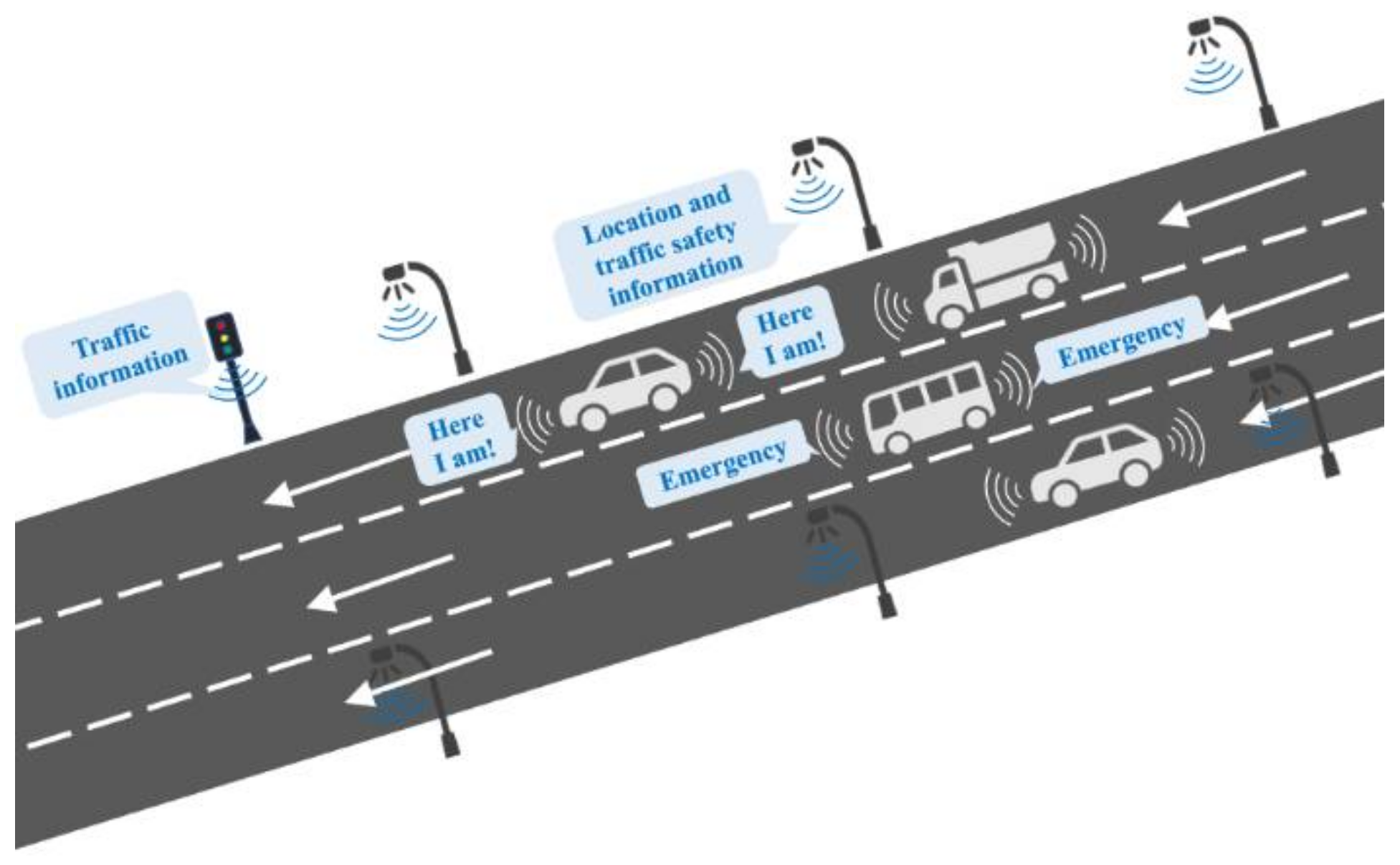



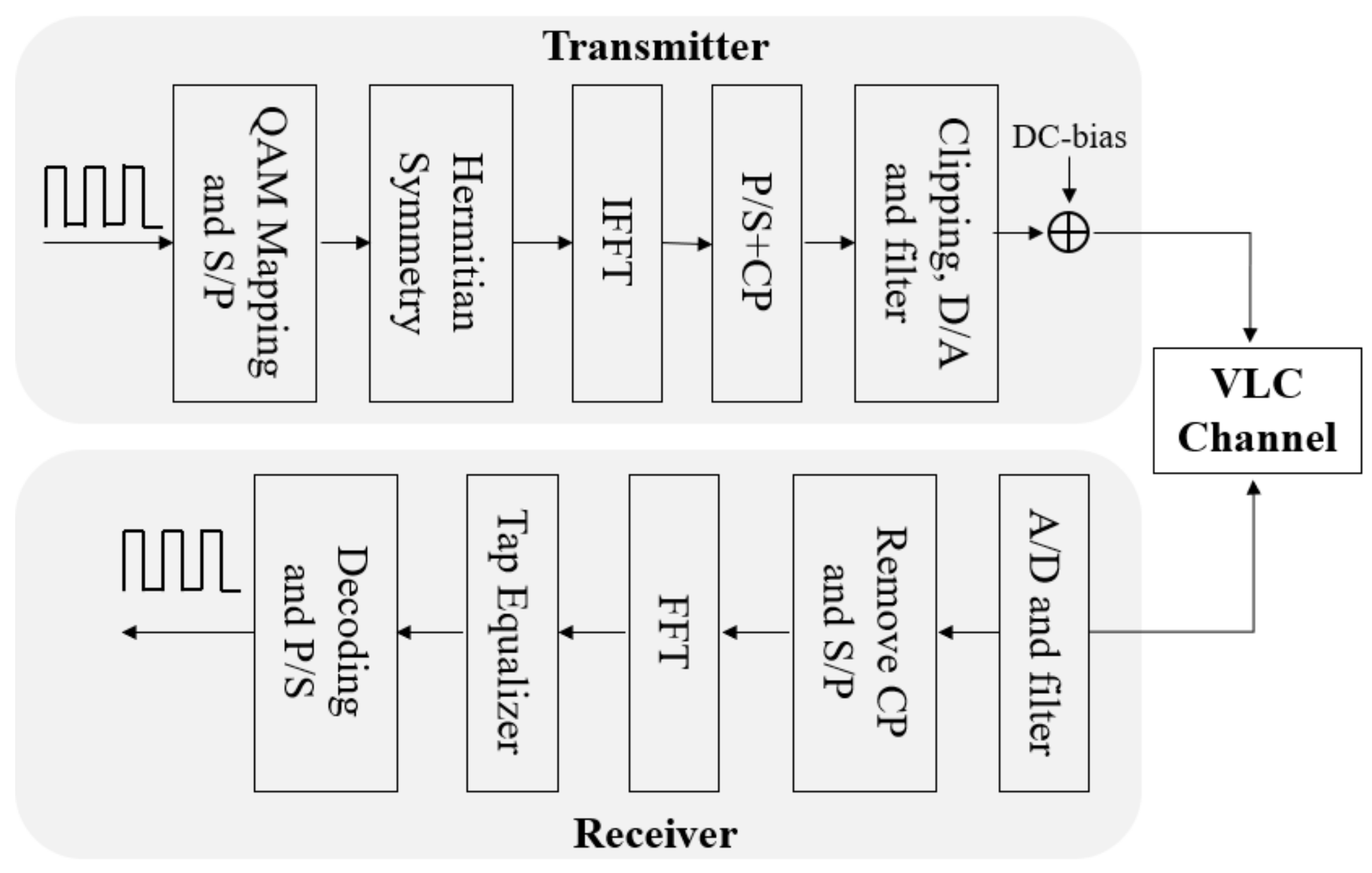

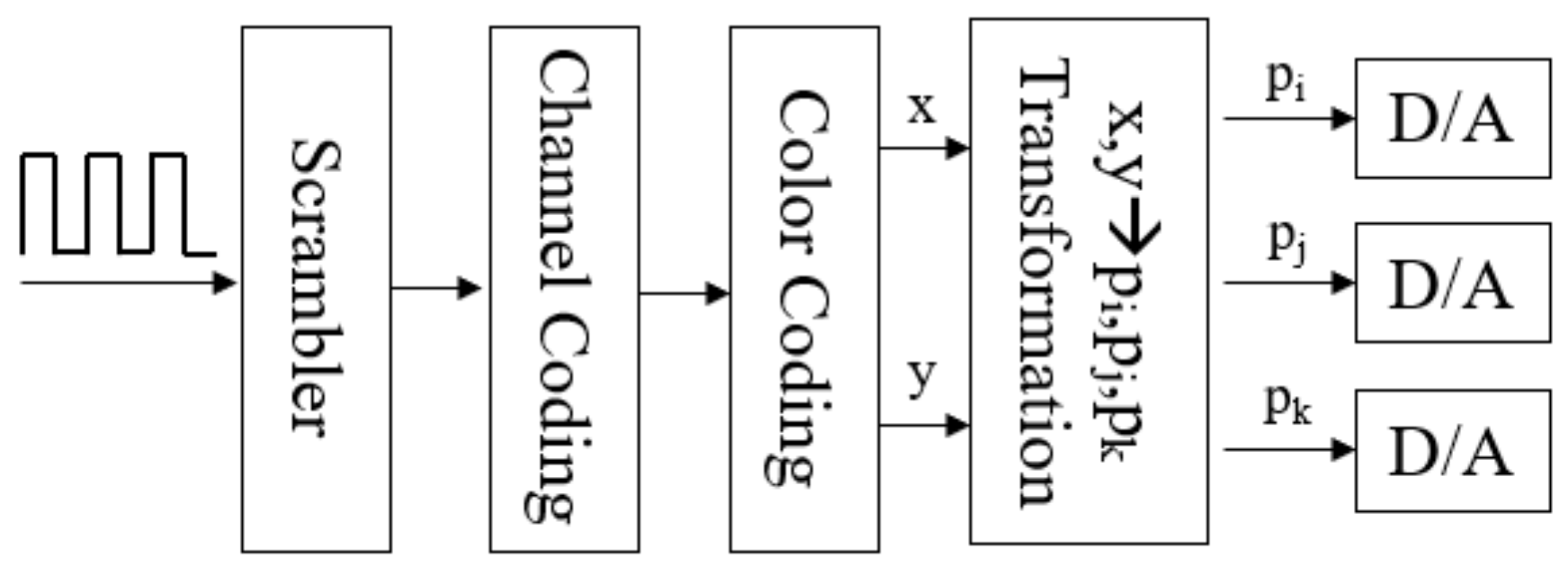
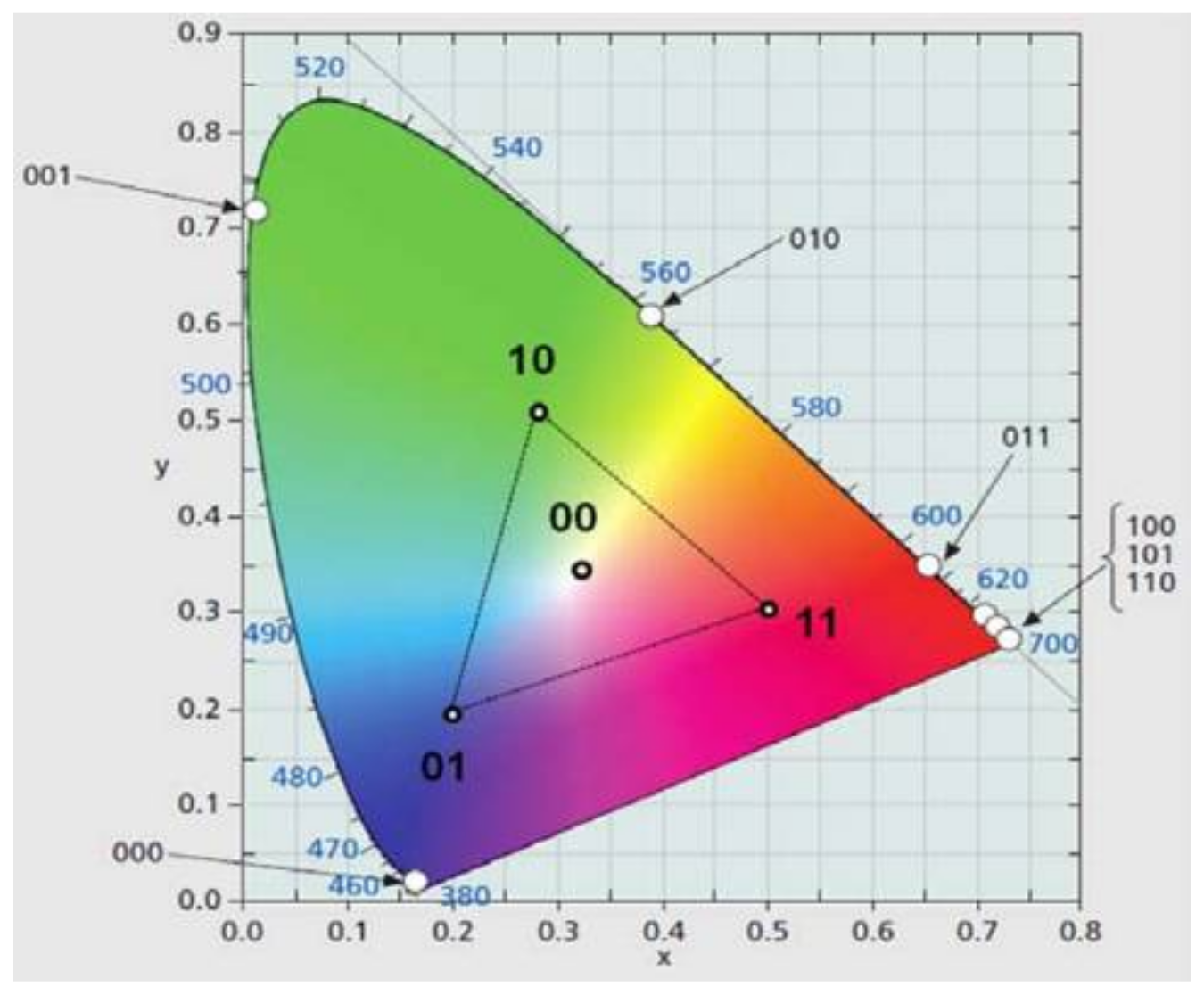

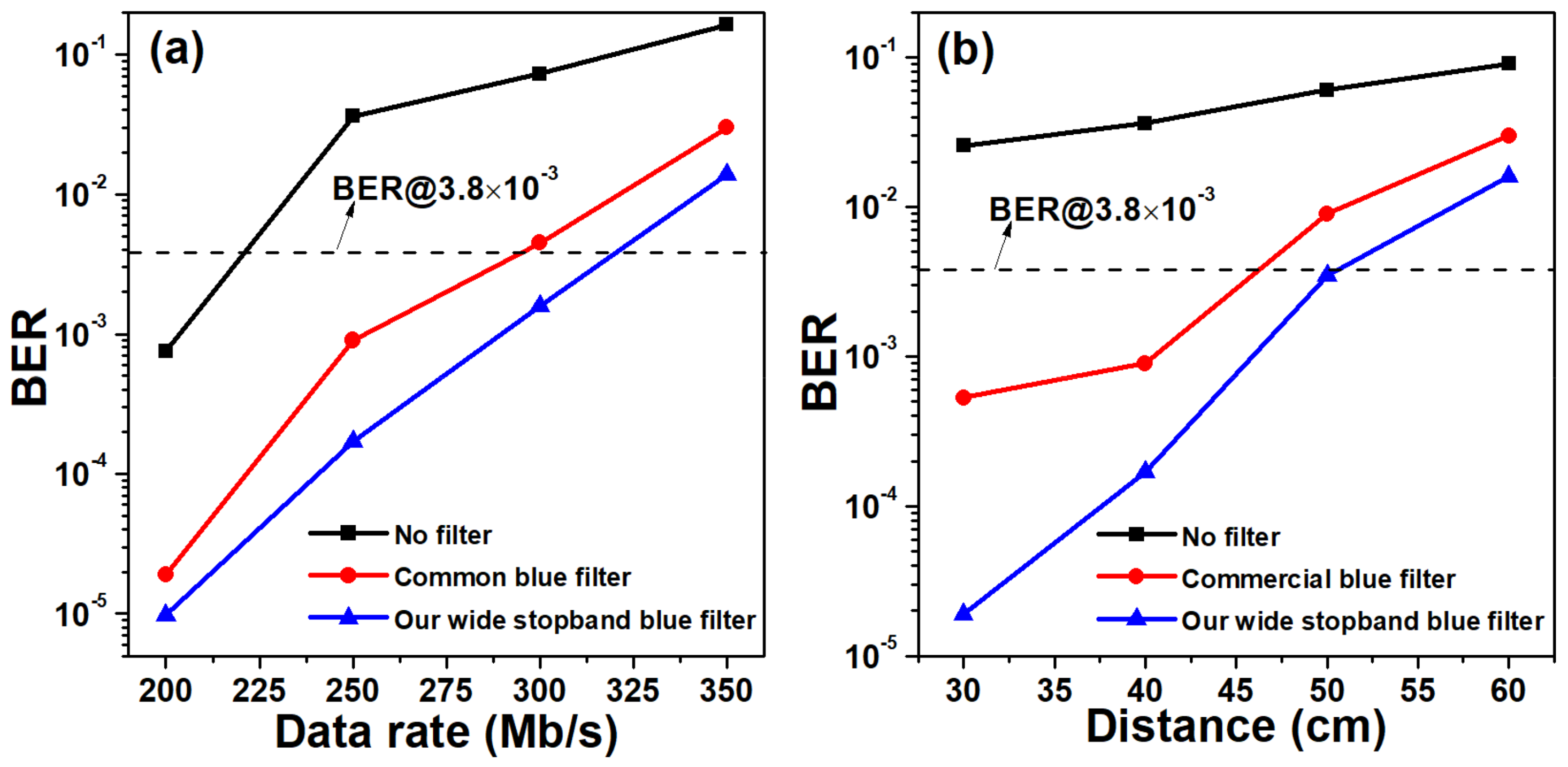
| Year | Transmitter | Receiver | Modulation | Data Rate | Distance | Comments | Ref. |
|---|---|---|---|---|---|---|---|
| 2017 | Blue LD | Ultrafast photodiode(UPD) | UFMC additive 16-QAM OFDM | 17.6 Gb/s | 16 m | / | [30] |
| 2017 | RYGB LDs | Imaging Diversity Receiver | OOK | 10 Gb/s | / | / | [59] |
| 2017 | NUV LD+ RGB phosphors | APD | OOK-NRZ | 1.25 Gb/s | 15 cm | / | [60] |
| 2017 | μ-LED | PIN | OFDM | 7.91 Gb/s | / | / | [28] |
| 2017 | μ-LED | APD | PAM(spatial) | 7 Gb/s | 0.5 m | 9 × 9 MIMO system Post-equalization | [61] |
| 2017 | RGB LED | PIN | OFDM(adaptive bit loading) | 6.36 Gb/s | 1 m | 2 × 2 MIMO system | [58] |
| 2017 | Red LED | silicon PN | OOK | 600 Mb/s | 6 m | 2 × 2 imaging MIMO system Pre- and Post-equalization | [62] |
| 2016 | LD | / | OOK | 1 Gb/s | / | / | [63] |
| 2016 | Red RC-LED and blue and green μ-LEDs | PIN | OFDM(WDM) | 10 Gb/s | 1.5 m | / | [64] |
| 2016 | μ-LED | / | DCO-OFDM | 5 Gb/s | / | [29] | |
| 2016 | μ-LED | / | PAM | 3.5 Gb/s | Post-equalization | [29] | |
| 2016 | μ-LED | APD | PAM | 2 Gb/s | 0.6 m | Pre-equalization | [65] |
| 2016 | RGB-LED | APD | QAM-OFDM | 1 Gb/s | 100 m | / | [66] |
| 2016 | ps-LED | PIN | OFDM (adaptive bit and power loading) | 2.08 Gb/s | 1 m | Pre-equalization | [48] |
| 2016 | ps-LED | PIN | OFDM (bit-loading) | 1 Gb/s | 0.6 m | 2 × 2 MIMO System Pre-equalization | [57] |
| 2015 | RGB LDs | PIN | OFDM(WDM) | 14 Gb/s | 2.8 m | / | [67] |
| 2015 | RGB LDs | APD | OFDM(WDM) | 4.4 Gb/s | 0.2 m | / | [68] |
| 2015 | Blue LDs | APD | OFDM | 9 Gb/s | 5 m | / | [69] |
| 2015 | Blue LD + phosphor | / | OFDM (adaptive bit and power loading) | 6.52 Gb/s | 0.35 m | / | [70] |
| 2015 | Blue LD + phosphor | APD | OFDM | 5.2 Gb/s | 0.6 m | / | [71] |
| 2015 | Blue LD + phosphor | APD | OFDM | 4 Gb/s | 0.5 m | / | [72] |
| 2015 | Blue LD + phosphor | APD | OOK | 4 Gb/s | / | / | [73] |
| 2015 | μ-LED + polymer color converter | APD | DCO-OFDM (WDM) | 2.3 Gb/s | / | / | [74] |
| 2015 | RYGB LED | PIN | CAP(WDM) | 8 Gb/s | 1 m | Pre- and Post-equalization | [41] |
| 2015 | RYGB LED | APD | OFDM(WDM) | 5.6 Gb/s | 4 m | [75] | |
| 2015 | RGB LED | PIN | CAP | 4.5 Gb/s | 2 m | Pre-equalization | [47] |
| 2015 | RGB LED | APD | QAM-OFDM | 750 Mb/s | / | Pre-equalization | [47] |
| 2015 | LED | PIN | OFDM(Spatial) | 1.4 Gb/s | 2.5 m | 2 × 2 imaging MIMO-VLC system | [76] |
| 2015 | ps-LED | APD | OFDM(adaptive bit and power loading) | 2 Gb/s | 1.5 m | Pre-equalization | [36] |
| 2015 | ps-LED | PIN | OFDM | 1.6 Gb/s | 1 m | Pre-equalization Blue filter | [54] |
| 2015 | ps-LED | APD | QAM-OFDM | 1.4 Gb/s | 0.8 m | Pre-equalization | [77] |
| 2015 | ps-LED | APD | OFDM(Spatial) | 1.3 Gb/s | 0.4 m | / | [78] |
| 2015 | ps-LED | PIN | PAM | 1.1 Gb/s | / | Post-equalization | [79] |
| 2015 | ps-LED | PIN | QAM-OFDM | 682 Mb/s | 1 m | Pre-equalization | [80] |
| 2014 | μ-LED | PD | OFDM(adaptive bit and power loading) | 3 Gb/s | 5 cm | / | [81] |
| 2014 | μ-LED + polymer color converter(white) | APD | OFDM | 1.68 Gb/s | 3 cm | / | [82] |
| 2014 | RGB LED | APD | QAM (Wavelength) | 4.22 Gb/s | / | / | [83] |
| 2014 | RGB LED | APD | CAP(WDM) | 1.35 Gb/s | 0.3 m | Pre- and Post-equalization | [49] |
| 2014 | RGB-LED | APD | 16-QAM (Polarisation) | 1 Gb/s | / | Post-equalization | [84] |
| 2014 | Blue-LED | APD | 4-QAM(Spatial) | 500 Mb/s | 0.3 m | 2 × 2 non-imaging MIMO System Post-equalization | [85] |
| 2014 | ps-LED | PIN | OOK-NRZ | 550 Mb/s | 0.6 m | Pre- and Post-equalization | [86] |
| 2014 | ps-LED | PIN | OOK-NRZ | 340 Mb/s | 0.43 m | Post-equalization Blue filter | [87] |
| 2014 | ps-LED | PIN | OOK-NRZ (Spatial) | 50 Mb/s | 2 m | Pre-equalization 4 × 4 Non-imaging MIMO system | [88] |
© 2018 by the authors. Licensee MDPI, Basel, Switzerland. This article is an open access article distributed under the terms and conditions of the Creative Commons Attribution (CC BY) license (http://creativecommons.org/licenses/by/4.0/).
Share and Cite
Ji, R.; Wang, S.; Liu, Q.; Lu, W. High-Speed Visible Light Communications: Enabling Technologies and State of the Art. Appl. Sci. 2018, 8, 589. https://doi.org/10.3390/app8040589
Ji R, Wang S, Liu Q, Lu W. High-Speed Visible Light Communications: Enabling Technologies and State of the Art. Applied Sciences. 2018; 8(4):589. https://doi.org/10.3390/app8040589
Chicago/Turabian StyleJi, Ruonan, Shaowei Wang, Qingquan Liu, and Wei Lu. 2018. "High-Speed Visible Light Communications: Enabling Technologies and State of the Art" Applied Sciences 8, no. 4: 589. https://doi.org/10.3390/app8040589





